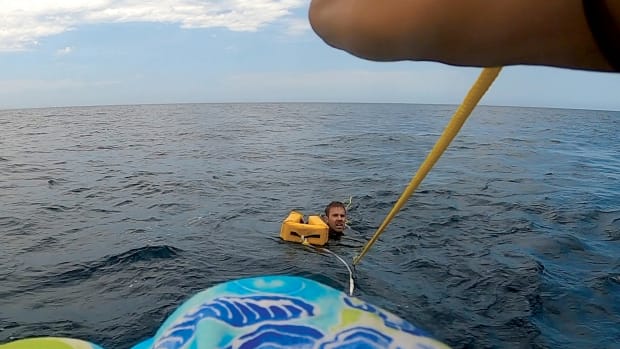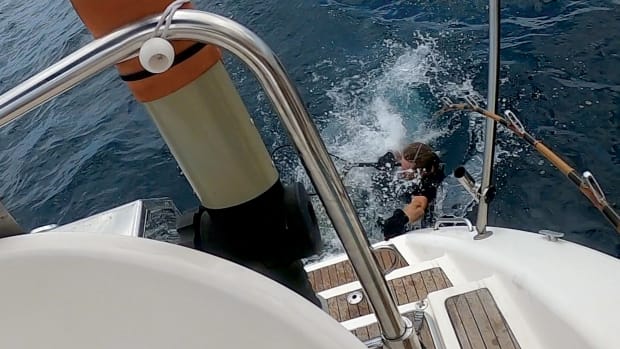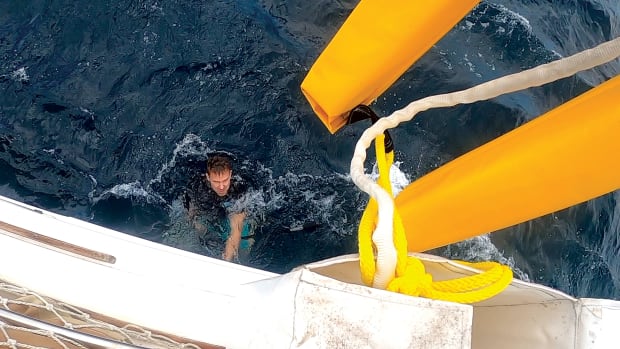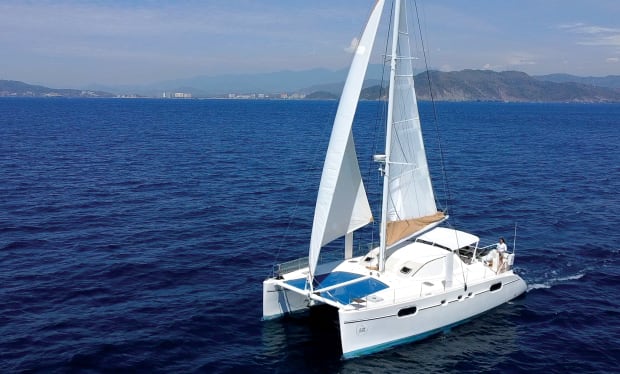
Photo by Linda Wehner
“I’m gonna lose you! Don’t let go…. Don’t let go!” Those were the words that I kept pleading to my husband as he clung to the Lifesling while I used all my adrenaline and grit to pull him back onboard. How we ended up there is a cautionary tale.
Like most days in the Sea of Cortez, the sea state was stable, the winds were mild, and the sky was bright blue with no foul weather forecast for days. It was a perfect day to make the quick 20-nautical-mile hop from Isla Coronado to Bahia San Juanico on La Vida Gypsea, our Catana 471 catamaran.
So, we lifted the anchor, hoisted the sails, and began doing our regular daily tasks. First, my husband, Kurt, started cleaning the lines and taking out the fishing rods, carefully choosing the proper lures, as we were running low on protein in the freezer. I began charging up our camera gear to get ready to film the daily events. By trade, we are content creators with a growing YouTube channel, and the day’s task for me was to complete a Q&A episode for our subscribers.

Photo by Linda Wehner
A few miles in, we quickly began to notice the swell starting to build. It was becoming a bit bothersome to record, as the boom kept banging and the mainsheet was slapping. After a few recording attempts, Kurt turned to me and said, “You know what? Today doesn’t seem like a good day to do this. It’s too loud. Let’s focus on getting to our anchorage and shoot when we get there.”
I begrudgingly agreed and turned off the camera. As we prepared to make lunch, the fishing reel on the starboard side began screeching. We jolted up, and instinctively I saw the opportune moment to pick up the GoPro. From a distance, we saw the familiar green and yellow flash that can only be made by our favorite fish; a huge dorado (mahi-mahi) was on the hook, and we wanted it on our boat.
Kurt quickly went into action by grabbing the fishing rod. “It’s gonna be a big one! We’re gonna need the net!”
I ran to the locker located up forward to port, jumped over the trampolines, and rushed back to him, net in tow. By the time I returned, the dorado was fighting hard at the sugar scoop; he was just as big as we’d thought.

Photo by Linda Wehner
“This sure beats the Q&A I was gonna record!” I excitedly called to the camera. I handed the net to Kurt, and he began to net our prize and pass me the fishing rod. However, the dorado had one more energy burst and began to flail ferociously.
And just like that, fish and net in hand, Kurt lost his footing, let out a howl as he smashed into the sugar scoop edge, and plunged into the water.
Never in my life have I felt the jolt of terror and adrenaline like what engulfed my entire body so quickly. I suddenly found myself entirely alone on our 47-foot catamaran with only my racing thoughts, a GoPro still actively filming in one hand, and the fishing rod tethering Kurt to the boat spooling out of control in the other. Watching him float farther away from me every second, I realized more and more the severity of the situation. He had no life jacket on, and we were still under full sail, making 4 to 6 knots.
To this day, I can’t say what triggered my instincts to finally kick in and push the fear aside to take action. Nonetheless, I did. I began talking to myself, walking through the steps of what needed to be done. I anxiously kept chanting, “What do I do? I don’t know what to do,” but my body seemed to be on autopilot as I began acting through my MOB training steps. I made my way to the engines and turned them on. I checked my position, turned into the wind to gain control of the boat, and heaved to, keeping my eyes on Kurt’s bobbing head.

Photo by Linda Wehner
As soon as I came about and safely approached him, I grabbed the Lifesling pack and tossed it to him. When he failed to catch it the first time, I quickly pulled it in and threw it again, ensuring he was secured.
“I’m gonna lose you! Don’t let go…. Don’t let go!” I kept pleading to my husband as he clung to the Lifesling while I used all my strength to pull him back onboard.
Once he was safely back in the cockpit, tears of relief overwhelmed me, and I threw myself at him to embrace him.
“Hold on a sec,” he said. Taken aback, I stared blankly at him and noticed that his hand still had the fishing net. “Grab the cooler. I don’t want this thing to go bad after everything we’ve been through.” I looked closer at the net, and there it was, the dorado that nearly cost Kurt his life.
“You held onto that thing the entire time you were out there floating?” I angrily yelled at him.
“Heck yeah, I did! And you still have the camera in your hand recording everything!” he retorted. We silently stared at each other, finally broke into laughter and held each other, relieved and thankful that this terrifying moment did not end another way.
We got lucky. Many people have different tales of their man overboard experiences that ended up with a crew member paying the ultimate price. Living out here as full-time cruisers, we get comfortable—arrogant even—and forget that this could happen to anyone, at any time, anywhere. After a few sleepless nights reliving the encounter in my dreams and a few days of self-reflection, Kurt and I reconvened and gathered our thoughts on what we had learned.

Photo by Linda Wehner
Final Notes
What about the camera The camera was on before Kurt fell overboard and remained on throughout the ordeal. As I was performing the maneuvers that required my full attention, I didn’t have it in my hands; most of the footage from those moments is either facing up into the sky or down into the cockpit cushion. But I did pick it up when I could—a habit and hazard of my trade, just like a weather reporter chasing a tornado instead of running from it, or a wildlife photographer running away from a stampede of buffalo while still rolling. We edited the footage to create a video of the incident, which we did publish on our channel.
Finally, as a woman in the sailing community, the best advice I can give to fellow women (or anyone who wants to live this lifestyle) is that you need to find strength daily to keep it up. With that said, it’s OK to cry, to be scared, and talk to yourself and ask, “What do I do?” to cue your mind to take action. Because deep down, you do know what to do. I hope that this story motivates cruisers—whether sailing or getting ready to—to be prepared for any situation. As the famous quote says, “If anything’s gonna happen, it’s gonna happen out there.”
What We Did Right:
Being the only person on board a vessel as large and powerful as our 47-foot catamaran and doing multiple things at once is not easy. I kept my eyes on Kurt, and thanks to the MOB training we had done a few months prior, I could quickly jump into action, even if I kept saying out loud that I didn’t know what I was doing. The number one thing done right (unconventional or not) was that I saved my husband, who is here today.
Despite my fear, I never took my eyes off Kurt, and I kept talking to him. Later, he said this helped keep him calm, and it helped me know he was OK.
What We Did Wrong:
Kurt should never have been on the sugar scoop without a life jacket or being tethered. But in reality, most full-time cruisers rarely have one on. We get overconfident, and overconfidence is your number one enemy out here.
Once Kurt was holding securely onto the Lifesling, I immediately jumped to the sugar scoop to start pulling him in. I hadn’t put on a tether or a life jacket to do this. If we both had fallen in, neither of us likely would be present to tell this story today.
Safety gear is only as good as the person deploying it. We had practiced MOB drills, traditional heave-to, and the figure-eight move. However, we had been cruising full-time for less than a year, and we had never actually taken the Lifesling out of its pack and practiced with it. Not until we needed it during a real emergency did we realize that it needed to be set up for us to deploy it more smoothly. When it was time for me to deploy it, I failed to notice that the flotation device attached to the rope was tangled and bunched all into one clump. If we had practiced more regularly, this never would have occurred, and deployment would have become second nature.
After leaving their jobs in Texas behind, Linda Wehner and her husband, Kurt, built an off-grid home in Panama and now sail La Vida Gypsy. You can find them on YouTube at SailingLaVidaGypsea and on Instagram @Sailing_La_Vida_Gypsea.
May 2023








